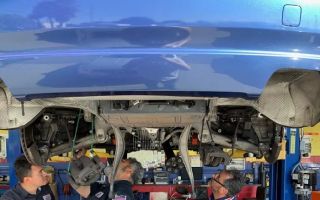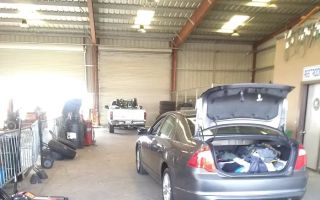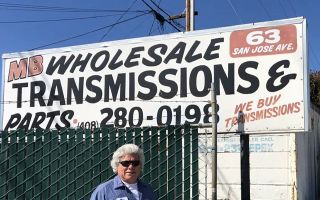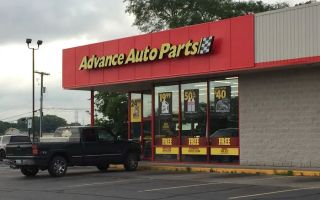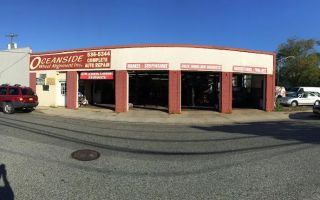How to Prevent Further Issues After a Flat Tire: A Personal Guide
We’ve all been there—driving down the road when suddenly, you feel the unmistakable thud of a flat tire. It's one of those inconvenient moments that always seems to happen at the worst possible time. A flat tire can be more than just an inconvenience; if not handled properly, it can lead to further issues that may cost you time and money. I’ve had my fair share of flat tire experiences, and after each one, I’ve learned valuable lessons on how to prevent further issues. Let me walk you through the steps I take to ensure my tire troubles don’t escalate.

MR. TIRE INC.
2078 New York Ave, Huntington Station, NY 11746, USA
1. Assessing the Situation: Stop and Inspect Immediately
After my first flat tire, I learned that the most important step is to act quickly but safely. The moment I realized my tire was flat, I safely pulled over to the side of the road. Keeping calm and staying composed is key. If you're driving on the highway or a busy road, don’t hesitate to use your hazard lights and look for a safe, flat place to park your car. Avoid stopping on a hill or in a location with limited visibility. Once the car is safely stopped, it’s time to inspect the tire and determine the cause of the issue.
In some cases, the flat may be a slow leak that you didn't notice. Other times, it may be a result of something sharp, like a nail or a piece of glass, puncturing the tire. If you're unsure about what caused the flat, it’s a good idea to call a professional towing service, such as Rescue & Towing, who can safely inspect the issue and ensure there are no other hidden problems. I once had a flat caused by a nail, but I didn’t realize that it had punctured the sidewall, which meant I couldn’t just repair it—I needed a new tire.

MR. TIRE INC.
2078 New York Ave, Huntington Station, NY 11746, USA
2. Avoid Further Damage: Don’t Drive on a Flat Tire
One mistake I made early on was attempting to drive on a flat tire, thinking that I could just make it a few more miles. I quickly learned that driving on a flat tire can cause severe damage to both the tire and the rim, which can lead to even costlier repairs. If you’ve got a flat tire, don’t try to continue driving, even if it seems like a short distance to a service station. The weight of the car pressing on the flat tire can damage the inner structure, making it impossible to repair. Not to mention, you risk damaging the rim, which can be a much more expensive fix than simply replacing the tire.
In situations where you’re unsure of the extent of the flat, the best option is to call a tow truck. In my case, I learned that sometimes it’s best to err on the side of caution. Calling a professional towing service, such as Rescue & Towing, ensures that your vehicle will be transported safely without causing further damage to your tires or wheels.
3. Properly Changing the Tire: Safety First
If you're confident that you can change the tire yourself, there are a few important steps to follow to avoid making the situation worse. I remember the first time I had to change a flat tire on my own. I was nervous, but I quickly learned the importance of using the correct tools and taking the proper steps. Here's what I do:
- Use a Jack Properly: Ensure that the jack is positioned under the car's lifting point, which is typically indicated in the car's manual. Incorrectly placing the jack can cause damage to the vehicle.
- Loosen the Lug Nuts: Before raising the car, I always loosen the lug nuts with a wrench. I don’t remove them completely until the car is lifted off the ground.
- Lift the Car: Slowly raise the car using the jack until the flat tire is off the ground. This will allow you to remove the tire without putting too much pressure on it.
- Replace the Tire: After removing the flat tire, I carefully place the spare on the wheel hub, making sure it is aligned properly with the holes for the lug nuts.
- Tighten the Lug Nuts: Once the new tire is in place, I tighten the lug nuts by hand and then use the wrench to secure them in a crisscross pattern to ensure an even fit.
By following these steps, I ensure that I don’t cause further damage to my car, and the tire change goes smoothly. However, if you feel uncertain about handling the situation yourself, it’s always a good idea to call for professional assistance, especially if you’re on the side of the road or in an unsafe location.
4. After the Repair: Check Your Tires Regularly
Once I’ve replaced the flat tire or had it repaired, I always make sure to check the new or repaired tire for any signs of further damage. Tire maintenance doesn’t end once the flat is dealt with. Regularly checking tire pressure and ensuring that the tires are properly inflated can help prevent further issues down the road. Low tire pressure is one of the leading causes of flats, and keeping your tires properly inflated helps reduce the risk of a blowout or another flat.
I've made it a habit to inspect my tires every few weeks. A quick visual inspection can help catch any potential issues, like nails or sharp objects embedded in the rubber. I also use a tire pressure gauge to ensure that my tires are within the recommended pressure range. It’s a simple step, but it goes a long way in preventing future tire problems.
5. When to Replace the Tire: Knowing When to Let Go
There are times when a tire can’t be saved, and I’ve had to face that reality a few times. A tire that has been punctured in certain areas, like the sidewall, can’t be repaired safely. Similarly, if the tread is worn too thin, it’s time to replace the tire. Driving on tires with insufficient tread increases the risk of hydroplaning, which is dangerous, especially in wet conditions.
I’ve learned that sometimes, it’s best to simply replace a tire rather than attempt a repair that may not last. If you have a spare, don’t hesitate to use it until you can get to a professional to replace the damaged tire. It’s always better to be proactive and replace a tire early rather than risk further damage to your vehicle or compromise your safety.
6. Call for Assistance When Needed: Professional Help Matters
In my experience, there are situations where calling in professional help is the best decision. I once found myself stranded in an area with no spare tire or jack, and I was relieved to know that I could rely on a reputable towing company to come to my rescue. Services like Rescue & Towing are equipped with the expertise and tools necessary to help in these types of situations, ensuring that your vehicle is safely transported without any further issues.
Whether it’s a flat tire on a busy road or a tire emergency in a remote location, having access to professional towing and tire services can make all the difference. These services not only help with flat tires but also offer peace of mind knowing that someone is there to help when you need it most.

